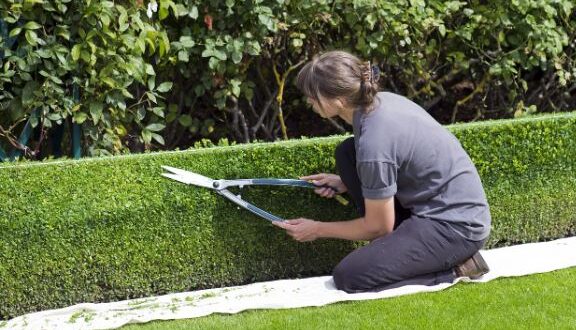If you’ve recently moved house and have become the proud owner of a beautiful garden hedge, or are wanting to save money on hiring professionals by giving your own garden maintenance work a go, you might be daunted by the prospect of trimming your own hedge, and will want to avoid creating a shoddy eyesore of a hedge that will attract the attention of your neighbours for all the wrong reasons.
But, with a few simple tips, you can enjoy a beautifully manicured hedge to admire all summer long. Read on to discover the ultimate beginners’ guide to hedge cutting.
Tools and safety equipment
Firstly, you’ll need all the necessary tools and safety equipment to begin trimming your hedge. Ensure you have a thick pair of gloves, goggles and protective footwear to avoid injury from handling or standing on any loose twigs or branches. Whilst you should always aim to keep your hedge at a height and width that is manageable, you should also ensure you have a sturdy stepladder to cut those hard-to-reach leaves.
Of course, you’ll need a pair of good-quality hedge trimmers to get the job done, as well as some secateurs or pruning shear, as these can be very useful for helping to tackle dense, low growth as well as evergreen hedges with larger leaves. Don’t forget that blunt tools create blunt cuts and snipping the ends of branches with blunt tools can actually be damaging to your hedge, as snipping off the end of one branch encourages between four and six additional branches to grow in its place, so you can end up making a lot more work for yourself. You should therefore aim to keep your handheld cutting tools sharp at all times.
How much should I cut off?
Most hedges benefit from a light trim a couple of times a year. Cutting your hedge regularly will encourage growth, making your garden look lush and vibrant, especially in the summer months.
If it’s your first time cutting the hedge, assess it first to see how much needs taking off. You should aim to trim between 1-4 inches of growth, but if it’s dominating your garden and encroaching onto your garden path, it might need a bit more taking off.
How to cut a hedge
When cutting the hedge, start from the bottom and work your way upwards. You don’t want to allow the hedge to become wider at the top, as this will affect the growth of leaves at the base. Less is more when it comes to hedge trimming, so start off by just carrying out a light trim around the edges, and then progress further, making sure to stop and check your progress regularly.
You can use a simple string line, which can be tied between two poles, to help keep the top of the hedge level, helping you avoid any unsightly top lines. Always keep your hedge trimmers level, too, and ensure you’re not staggering cuts.
Check for wildlife
Don’t forget to scour the hedge for any signs of wildlife, including nesting birds. If you do find any, you should either delay trimming the hedge until the birds have fledged and left the nest, or ensure to trim around that section to protect them and avoid disturbing them.
Plus, remember to compost your hedge clippings once done, so you can use them in winter to promote healthy leaves for next summer. You can mow over larger hedge leaves to help cut them up further, before adding them to your compost bin where they can easily break down.
 Gardeners Club The Gardeners Club is a free to join online club for everyone with an interest in gardening and gardens.
Gardeners Club The Gardeners Club is a free to join online club for everyone with an interest in gardening and gardens.






